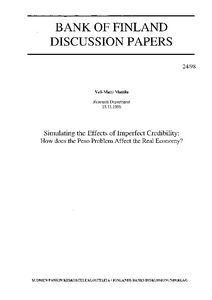Simulating the effects of imperfect credibility : How dos the Peso problem affect the real economy?
Mattila, Veli-Matti (13.11.1998)
Numero
24/1998Julkaisija
Suomen Pankki
1998
Julkaisun pysyvä osoite on
https://urn.fi/URN:NBN:fi:bof-20140807594Tiivistelmä
In this paper we analyse the macroeconomic effects of peso problems by simulating numerically a small-scale rational expectations macromodel.The model is a conventional IS-LM-AS model of an open economy under floating exchange rates.The peso problem has been incorporated in the model by assuming that the money supply process entails a small but nonzero probability of a sizable discrete shift in the money supply.In addition, the severity of a peso problem can vary over time.The procedure used in solving our model is more complicated than the standard solution methods for rational expectation models in that there are two dates at which expectations are formed. Both deterministic and stochastic simulations were used in the analysis.Results from the deterministic simulations suggest that the presence of the peso problem leads to an overvalued real exchange rate and a higher ex ante real interest rate, which results in output losses.In the stochastic simulations, the values of the IS, AS and monetary disturbances vary along with the severity of the peso problem.The simulations show that the presence of a variable peso problem affects the correlations between macroeconomic variables, especially between the ex post yield differential and either the real exchange rate or the output gap.In the case of conventional (non-autocorrelated) IS, AS and monetary disturbances, these correlation coefficients are equal to, zero.The inclusion of a variable peso problem in the simulation model changes these results: the ex post yield differential is now correlated with the real exchange rate and the output gap. In the empirical part of the paper we demonstrate the applicability of our simulation results using Canada and the United Kingdom as examples. Keywords: peso problem, credibility, simulation
